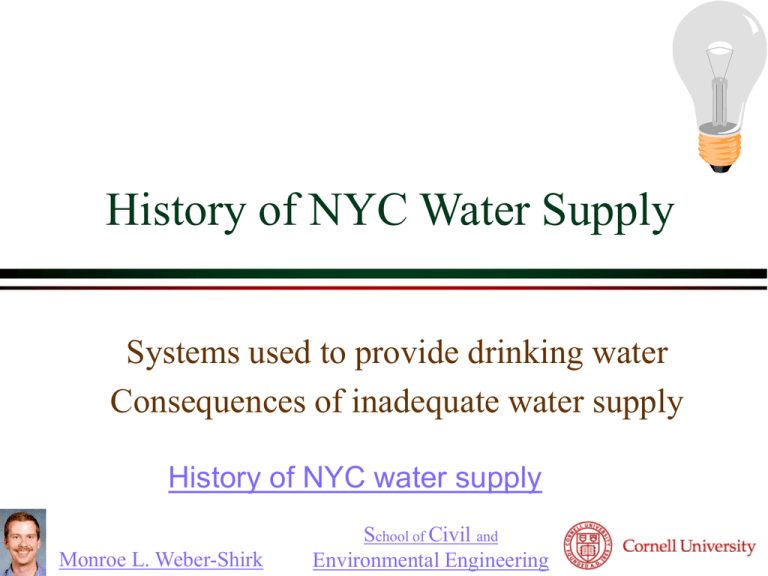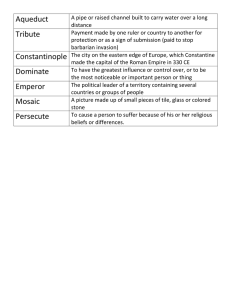History of NYC water supply
advertisement

History of NYC Water Supply Systems used to provide drinking water Consequences of inadequate water supply History of NYC water supply Monroe L. Weber-Shirk School of Civil and Environmental Engineering Drinking Water Systems Wells and springs 1664 - 1842 Croton Aqueduct 1842 New Croton System 1890 Catskill System Stage 1 1917 Catskill System Stage 2 1928 Delaware System 1937-1964 Early History (Wells) 1626 - Peter Minuit purchased Manhattan Island from the Indians 1664 (1500 inhabitants) - water obtained from private wells 1658 - first public well was dug near Bowling Green. More public wells were dug at the street corners. Pre-Revolutionary War History 1750 - water drawn from many of the public wells was notoriously foul The absence of a sewer system permitted much “unwholesome matter” to find its way into the ground. (Hall, 1917) “Tubbs of odour and nastiness” were emptied into the street... (Hall, 1917) 1774 (30,000 inhabitants) - water shortage Fire “On September 21, 1776, six days after the British captured the city, a fire broke out at the foot of Whitetail street and spread to Broadway, burning up on the east side as far as Mr. Harrison's brick house and on the west side to St. Paul's chapel. Trinity church and 493 houses were destroyed.” Frisbie, R. (Ed.). (1993). Water for New York City. Saugerties NY: Hope Farm Press. “The fire of 1776 destroyed almost one quarter of the houses in the city. Weidner, C. H. (1974). Water for a City: A History of New York City's Problem from the Beginning to the Delaware River System. New York: Rutgers University Press. First Water Works (shortly before the revolution) 1774 - Common Council made its first move to construct a _________________ municipally owned water supply system Christopher Colles, an English civil engineer attempted to pump water from wells and the Collect (a pond) through hollow logs to a reservoir at Broadway and White Street using a “Newcommen engine” The revolution interrupted the work Disease In 1798 yellow fever took the lives of two thousand persons in New York City. The annual deaths from cholera, typhoid fever, and other diseases directly attributable to contaminated water and wretched sanitary conditions at the time that yellow fever was making its regular visitations in the 1790s and 1800s will never be known. From all accounts the number was great. Weidner, C. H. (1974). Water for a City: A History of New York City's Problem from the Beginning to the Delaware River System. New York: Rutgers University Press. Disease There were epidemics of yellow fever in 1795, 1798, 1805, 1819, and 1822, and of cholera in 1832, 1834, 1849, and 1855. The epidemic of 1805 was particularly severe. John Lambert's diary says that in that year 26,000 persons moved from the interior of the City to Greenwich village to escape the plague. Frisbie, R. (Ed.). (1993). Water for New York City. Saugerties NY: Hope Farm Press. The Manhattan Company 1799 - Common Council submitted to the New York state legislature a bill to grant the city of New York with pure and wholesome water. The bill included a provision for the incorporation of the Manhattan Company (Aaron Burr, Daniel Ludlow, John B. Church…) said company was to pursue “the laudable undertaking [of supplying the city with water], which promised, under the blessing of God, to be conducive to the health and safety of the inhabitants of said city.” Burr included a clause in the Bill “providing that its surplus capital might be employed in any transactions not inconsistent with the laws of the State.” A capital of $2,000,000 was at once provided, and the Manhattan Company’s Bank began its long and successful career. flow of capital, not flow of water… The Manhattan Company 1799 - reservoir of 550,000 gallons and a new well, 6 miles of wooden pipes and water to 400 families 1808 - 20 miles of wooden pipes 1809 - tree roots clogged many of the original pipes 1812 - interrupted service for 5 weeks while installing a new pump engine 1830 - 40 miles of wooden pipes and water to about 60,000 (Manhattan had a population of 200,000) Provided 700,000 gallons/day C.H. Weidner, Water for a City: A History of New York City's Problem from the Beginning to the Delaware River System, Rutgers University Press, New York (1974).page 22 More Fires Disastrous fires, which might have been controlled had there been an adequate supply of water, occurred in 1828 and 1835. The latter leveled twenty blocks and was stopped only by blowing up buildings in its path. Before it was extinguished it had destroyed 674 buildings, 530 of which were stores or commercial establishments. Estimates of property loss were as high as $40,000,000. More than fifteen hundred merchants were ruined; several thousand clerks and laborers were thrown out of work. Nearly all the fire insurance companies in the city went bankrupt.” Weidner, C. H. (1974). Water for a City: A History of New York City's Problem from the Beginning to the Delaware River System. New York: Rutgers University Press. NYCFD Col. Clinton’s 1832 report Shipping paid $50,000 per year for water supplied from Long Island and New Jersey Many ships carried enough water to last them for the journey back to Europe to avoid having to use NYC water! Clinton recommended a dam on the Croton river with an aqueduct to transport the water to NYC Old Croton Aqueduct Follows the surface of the ground along the bank of the Croton River to the Hudson, and along the Hudson to Yonkers. Capacity 72 to 95 million gallons/day 1842 population served was 300,000 per capita consumption was expected to be 22 gallons/day Old Croton Aqueduct Inadequacy of Old Croton Aqueduct and Reservoir 25 years after completion the aqueduct was running at more than its design capacity Croton reservoir was also inadequate Severe shortages of water in 1869, 1871, 1880, 1881. All reservoirs emptied Lakes in Croton watershed emptied by condemnation (with violent opposition from the property owners) New Croton Aqueduct Aqueduct opened in 1890 15 ft diameter tunnel 50 to 500 ft below surface not pressurized 33.1 miles long capacity 340 million gallons/day water consumption jumped from 102 mgd to 170 mgd by _____ 1899 demand was exceeding the supply New Croton Dam The New Croton Dam began construction in 1892 and was completed on New Years Day 1907 The Dam cost New York City approximately 12 million dollars It was built in large part by Irish, German and Italian immigrants New Croton Dam Catskill System Stage 1: More Water! Completed in 1917 Ashokan Reservoir Catskill Aqueduct Kensico Reservoir Hillview Reservoir City Tunnel 1 Silver Lake Reservoir in Staten Island Catskill System Stage 2: More Water! Schoharie watershed Enlarged city distribution system Catskill system completed in 1928 Provided 614 mgd 1932 estimated to be the time when the demand would once again exceed supply Delaware System 1931 - The US Supreme Court handed down a decree permitting NYC, under certain conditions, to take 440 mgd from the tributaries of the Delaware River NYC required to build a wastewater treatment plant at Port Jervis NYC was required to maintain a minimum flow at Port Jervis, NY and at Trenton NJ Currently 1520 cubic feet per second required in the Delaware River at Montague, NJ Delaware System 170 miles of deep-rock pressure and grade tunnels Designed to carry all the water available in the Delaware River watershed 1 bgd (billion gallons/day) Construction from 1937-1964 No treatment beyond chlorination Supply Aqueducts and Tunnels Catskill Aqueduct (1915) Shandaken Tunnel (1928) Delaware Aqueduct (1944) Neversink Tunnel (1950) East Delaware Tunnel (1954) West Delaware Tunnel (1967) NYC Population population 10,000,000 1,000,000 100,000 1800 1850 1900 year 1950 2000 Filtration Prediction I venture to express the belief that by 20 years hence the public will have become educated to demand a higher standard of purity in public water supplies and that all future work should be laid out with a view to filtration 10 or 20 years hence of all water entering the distribution system. The conduits should run past land suitable for filter beds and head or fall be reserved suitable for working the filters without any expense for pumping. Personally, I believe that with complete meters and proper waste restriction filters could be properly advised at once for the Croton supply, and I find as detailed in the report that to filter the present supply with all its waste would cost only about 35 cents per capita per year. J.R. Freeman, Report upon New York's Water Supply, Martin B. Brown Co., New York (1900). p. 12 NYC Water Supply Summary NYC almost continuously expanded its water supply from the beginning until the late 1960s NYC continues to expand its water distribution system NYC water demand has stabilized NYC is focusing its efforts on water quality and on water conservation Brainstorm! Water Sources for NYC Source Advantages Disadvantages Old Croton Aqueduct Historic view of the Old Croton Aqueduct being reconstructed in the Division Wall of the Jerome Park Reservoir in 1898 (1907 Report to the Aqueduct Commissioners). Saw Mill River Bridge Historic illustration of the Saw Mill River Bridge, Old Croton Aqueduct, Yonkers (Tower, 1843). High Bridge Carried the Old Croton aqueduct over the Harlem River into Manhattan High Bridge Historic illustration of the High Bridge over the Harlem River, just prior to its completion. Manhattan Island is at left, "The Continent of America" at right (Schramke, 1846). New Croton Dam New Croton Dam NYC Fire Department Old Croton Dam Constructed between 1837 and 1842 50 ft high (elevation 166.2 ft) 240 ft wide spillway Cornell’s Hydraulic Experiments An investigation by experiments on full-size model of the Croton dam crests-made in the new hydraulic laboratory of Cornell University - proves that the formula used heretofore for computing the water wasted exaggerated this flow about 9 per cent. J.R. Freeman, Report upon New York's Water Supply, Martin B. Brown Co., New York (1900). page 13 Watersheds Port Jervis Port Jervis





